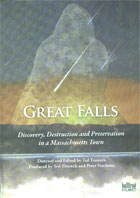
Great Falls: Discovery, Destruction and Preservation in a Massachusetts Town 2011
Distributed by Bullfrog Films, PO Box 149, Oley, PA 19547; 800-543-FROG (3764)
Produced by Ted Timreck and Peter Frechette
Directed by Ted Timreck
DVD, color, 83 min.
Sr. High - General Adult
Anthropology, Archaeology, History, Native American Studies, American Studies, Sociology
Date Entered: 05/23/2013
Reviewed by Jessica Isler, Academic Librarian, University of Maine at AugustaGreat Falls sets forth to describe both the history and more current context of Native American traditions, a history that anthropologists are still debating and unearthing. Investigation in this part of the film centers around land near Turners Falls, Massachusetts and a local airport there, and the importance of that land for local Native American tribes, the Narragansett and Pocumtuck. What is revealed is a set of interconnected stone structures and sites, said to hold spiritual and ceremonial significance. In 2008 the National Register of Historic Places deems the stone sites at the Turners Falls hillside the first of their kind to be eligible for inclusion on the register, but not before the land and sites are irreparably disturbed. In spite of the dismaying treatment of the land, town officials take steps to reconcile and acknowledge the tribal significance of the region, with town officials and Native American representatives partaking in ceremonies intended to cleanse the breach, and this is cited as a model for similar situations.
Halfway through the film, discussion veers both Southeast and Northwest (as far away as Northern New York State). Anthropologists and astronomers trace the positions of other stone sites and using ethno-astronomy, positing theories about their use as navigational systems. The ideas that Native American tribes were more interconnected than previously thought, and many more sites of archeological interest remain throughout Northeastern United States are intriguing and worthy of investigation. To be sure, this portion of the film is engaging, but I was left with lingering questions about the earlier section of the film and the fate of the Turners Falls sites. It seemed like the second topic could have warranted its own full-length documentary feature, and that the resulting film was a bit crowded.